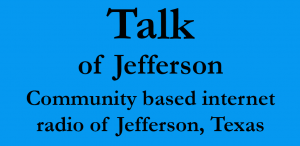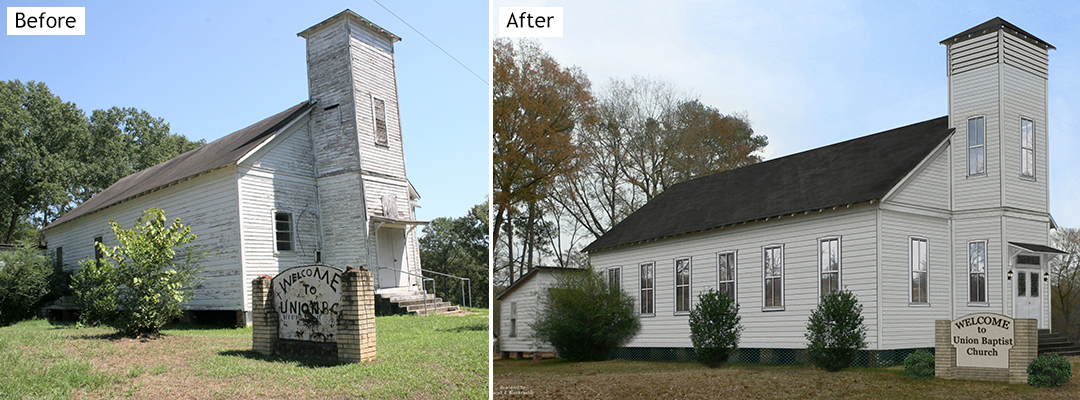
The Union Baptist Church has been a historic center of worship for black residents in Jefferson, Texas since 1842, when its doors opened to all people of color. Thanks to the interest and support of the local community, and their partnership with the Collins Academy team, the church site is facing a restoration.
Historical Significance
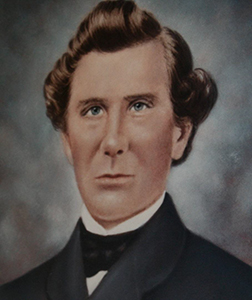
Captain William Perry
Captain William Perry gave the Houston Street property to local slaves shortly after his arrival at the location that would become the bustling port of Jefferson. The first structure was erected on the site in 1847 and was built using native cypress lumber for a non-denominational congregation and represents one of the earliest churches in Texas. A formal congregation, the Union Baptist Church, was established there in 1868 by Reverend Duncan. The first structure was burned in October – November 1868 as part of the local backlash from the punitive reconstruction policies of the United States Government at the close of the American Civil War.
Its importance lies in the fact that the church was the epicenter of Loyal League, Radical Republican, and Freedmen’s Bureau activities in Marion County during reconstruction and was a literal as well as a symbolic site of white, disenfranchised retribution and black suffering. Its life chronicles the deep and often violent racial divide in East Texas after the Civil War.
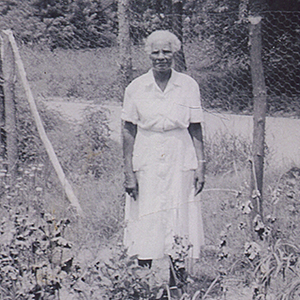
 The following account from the Records of the Assistant Commissioner for the State of Texas describes a tragic event associated with the first structure on the site:
The following account from the Records of the Assistant Commissioner for the State of Texas describes a tragic event associated with the first structure on the site:
“Jefferson, August 26, 1868: Last Friday night about 1 o’clock, Albert Browning (a Freedman), one of the quiet inoffensive citizens of our city, was taken out from his bed and in the presence of his wife and little children, his hands tied behind him and after being robbed of his money and many articles of wearing apparel, also a gun, pistol, and his horse, was led a short distance from his house and shot through the head, five balls taking effect, evidently simultaneously from different guns or pistols – as but one report was heard. From there they proceeded to the African church, tied their horses and entered the enclosure and commenced breaking down the door, whereupon some Freedmen who were there guarding their church fired upon them, and they ingloriously fled, and in their confusion they dropped the gun and pistol they had taken from Browning, and some other articles of value – also Browning’s horse was left tied to a stake. Since that time our city has been in a blaze of excitement, not so much on account of the assassination as from the assemblage of Freedmen at their church every night for the purpose of protecting their property, which is certainly their right, since the civil authorities fail to do it. They go to their church, enter the enclosure, fasten their gates and remain very quiet, interrupting no one, not wishing to interfere with anyone, provided they are left unmolested —“
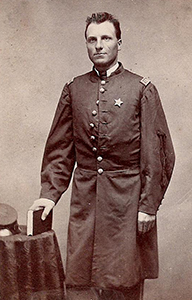
George Webster Smith
The church was burned shortly after the murder of George Webster Smith, a former union soldier who came to Jefferson as an aspiring businessman in 1866. It was his beliefs that set off a chain of events that led to the demise of the first structure, his assassination and the killing of two Freedmen, Jefferson being placed under martial law, local elected officials including the mayor being replaced, and the incarceration and military trial of 23 members of a vigilante group known as the Knights of the Rising Sun, the organization to which many of the accused belonged.
Smith’s heavy involvement with reconstruction efforts included appointment to the voter registration board of Marion County by the military district where he was responsible for voter registration. He was one of three people appointed to that board, which disenfranchised many former confederates. Smith held Freedmen voter rallies at various places around Jefferson including the church.
The Radical Republicans held voter meetings across the area. These helped bring about the lawlessness and violence against Freedmen and their place of worship. Smith served at the 1868 convention to draft the constitution for Texas’ re-entry into the United States. He was elected by a majority of black voters.
All federal troops were removed from Jefferson by June of 1871.
The building of a new church occurred after troop withdrawal was completed. The new structure was present when one of Jefferson’s prominent citizens, Mr. L.S. Schluter, stepped forward to assist the congregation in 1883. The deed he presented reads,
“The State of Texas, County of Marion. Know all men by these presents that L. S. Schluter of the County of Marion and State of Texas in consideration of the sum of fifty dollars to use in land paid Jordan Tice, Henry Bayley and Don Word as trustees of the Union Baptist Church (colored) of Jefferson Texas. Having granted, sold and conveyed and by these presents do grant, sell and convey unto the said church and its trustees, and their successors forever for the use and benefit of said Church of the County of Marion and the State of Texas, all that certain lot or parcel of land lying and being situated in the City of Jefferson as drawn by Hugh Henesey for Allen Urquhart as Lot No. (8) Eight in block No. Eighty-Six (86) fronting Houston Street.”
The building features a main sanctuary with a bell tower and also has a few smaller meeting rooms behind it. Separate from the building, is an outdoor sunken brick baptismal.
Over the years, the church building has fallen into disrepair. The Sept/Oct 2003 issue of Texas Historical Commission’s The Medallion featured a photograph of the Union Baptist Church as a part of the article, “Help Needed: The THC Introduces The Endangered Landmarks Program.” A non-profit organization consisting of congregation members and other interested parties, including the Collins Academy are now spearheading the efforts to restore the church and preserve its African-American heritage. The Marshall News Messenger newspaper stated that “the church’s remarkable history, started by area slaves, makes it a prime candidate for preservation and restoration as one of the oldest black churches in East Texas.”
Restoration efforts have stabilized the building while continued preservation is examined and implemented. At present, the church building continues to serve as a symbol of the Marion County African-American community identity.
During the first forty-five years of the new church, the congregation had only eight pastors: Revs. Duncan, A.B.C. McBride, N. Beckham (who served 20 years, longer than any other pastor of that era), J.H Patterson, J.J. Jones, R.A. Granger, H.B. Evans, and Rev. W.W. Web of Marshall, Texas. It was a place of stability – few churches in the district had such a small number of pastoral changes in the same length of time.
The following deacons served the church during that period: Dan Heynes, Henry Bagby, A. Clark, H. Cornell, B.J. Simmons, Peter Smith, and Dan Ward. The church ordained these ministers and sent them out to preach the gospel: Revs. A. Long, Hal Hawkins, R.D. Barnett, and J.C. Mitchell.
According to a 1917 writing, the Union Baptist Church “has a membership of 180, and pays its pastor $200 per annum. The church has a splendid Sunday School, Star Light Band, and W.H.M. Society. The church stands for the interest of the denomination in all the phases of its work.”
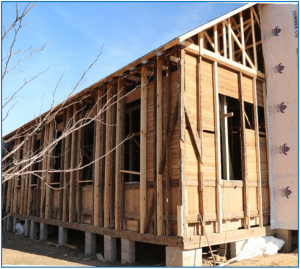 Click here for a Restoration Report
Click here for a Restoration Report
Click on the Play button for a story surrounding the UBC Church, by Lindsey Joyce.
